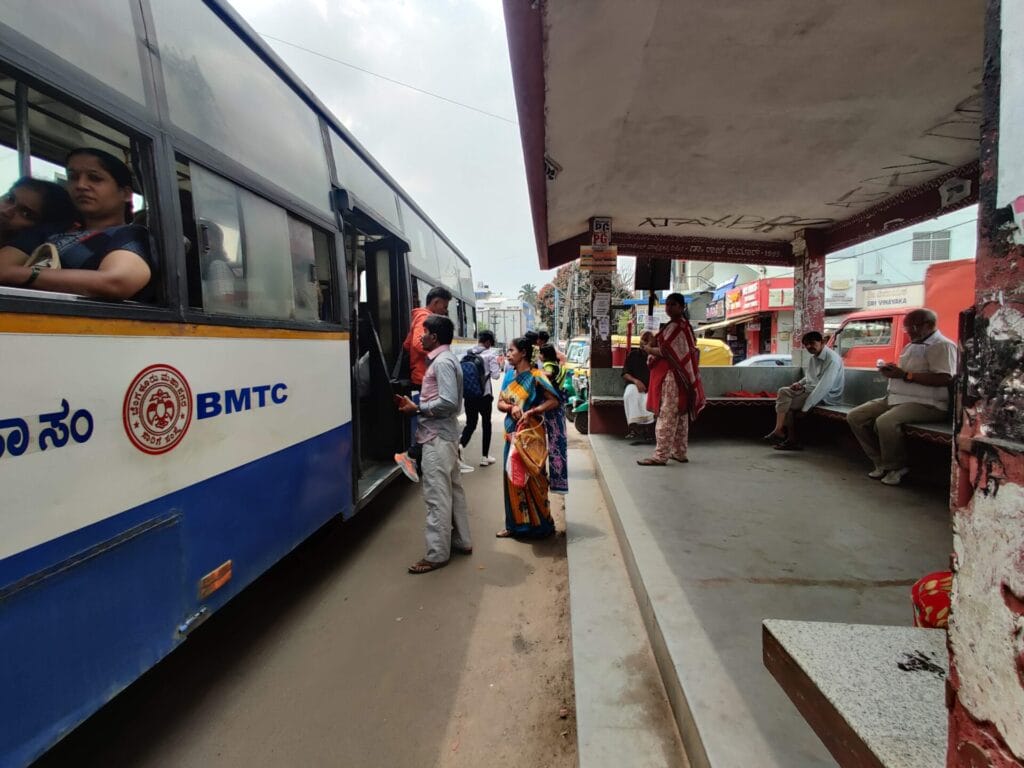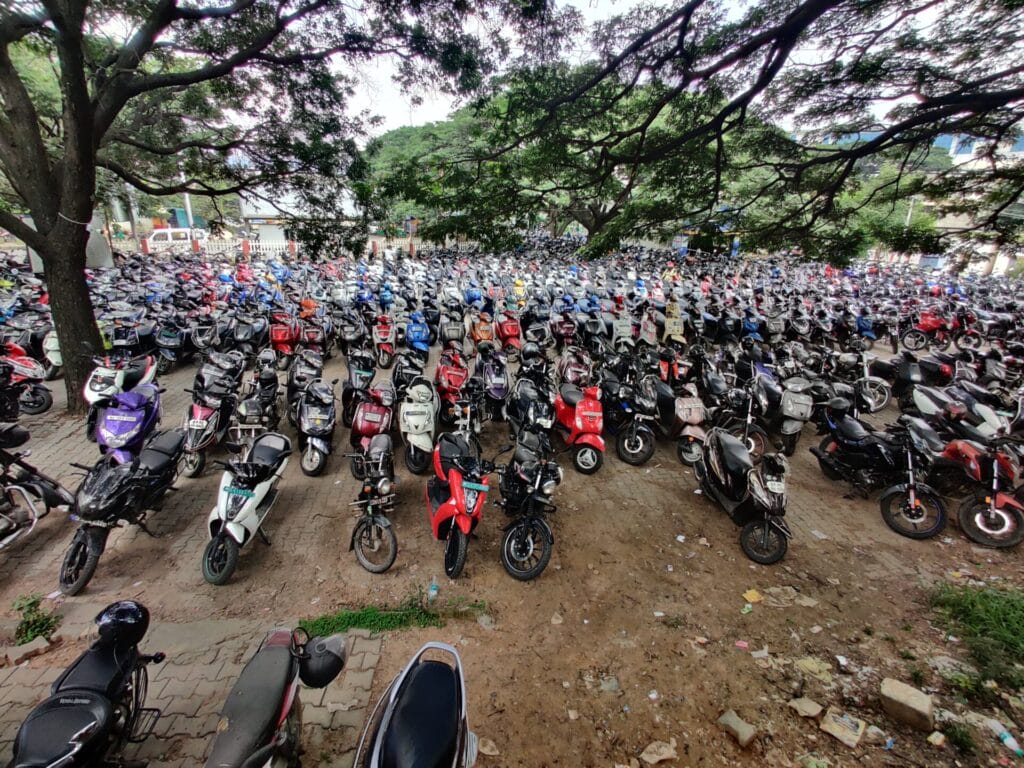If you lived close to a metro station, would you use the metro for your daily commute? The answer is not so obvious. A study by researchers from the National Institute of Advanced Studies (NIAS) found that the urban poor in Bengaluru do not prefer the metro even when it is located close to their homes.
The study found that the Bengaluru Metro Rail Corporation Limited (BMRCL’s) metro system was unaffordable for these residents, who instead relied on walking, BMTC and two wheelers. However, a few tweaks can make the metro more accessible and sustainable than it is currently, according to the study published in the journal Transport Policy.
The study is part of the doctoral work of PhD scholar Tanmay Ghosh. “My thesis mainly explores issues related to accessibility to first and last mile connectivity, public transportation affordability, mode choice analysis, and feeder network analysis with equity as the central theme.”

Affordable, accessible public transport
One of the UN’s sustainable development goals to combat climate change is making cities more climate resilient, inclusive and sustainable. As part of this goal , India and other countries are supposed to “provide access to safe, affordable, accessible and sustainable transport systems for all” by 2030. But it appears that currently the Bengaluru metro is far from meeting these targets.
During pilot surveys, Tanmay and his colleagues found that several low-income communities lived within 1.5 kilometres of existing metro stations but were not using the metro for their commute. To understand why this was happening, the researchers interviewed 5,730 individuals from 1,350 households across 16 wards in the city. Ten of these wards had metro stations for the existing Phase 1 and Phase 2 lines. The remaining six wards were sites of future metro stations as part of the proposed 2A, 2B phases.
An overwhelming majority of the people interviewed were poor. Most (81%) earned less than Rs 10,000 per month. Around 18 % earned between Rs 10,000-30,000 and less than 1% earned more than Rs 30,000 per month. Most of the people interviewed were between the 18 and 45 ages group; 51% were men while 49% were women.
Metro unpopular among the urban poor
Most of the people interviewed commuted regularly but hardly anyone used the Metro. Only 4% of the residents living close to an existing metro station travelled by Metro while less than 1 % of the people living near future metro stations used metro currently. In wards with current and future metro stations, over a third of the residents interviewed said they walked as a way of commuting.
Around 29% of the people living near metro stations also depended on BMTC. Over 22% of the people living near metro stations also depended on two-wheelers. Men tended to travel by two-wheelers more and a slightly higher proportion of women tended to use BMTC buses. Note: The study was done before the Shakti (free bus) scheme was introduced.

Residents living close to metro stations were primarily rejecting the metro because of the cost. “We further analysed the implication of switching from bus to metro and found that the proportion of travel cost to household income significantly increases,” explains Tanmay.
Unaffordable metro
The study notes that the average monthly income of residents using the Metro was around Rs 13,544 and they spent Rs 1,152 on travel. The residents who used the BMTC bus earned Rs 6,104 per month on average and spent around Rs 378 on bus fares.
Tanmay also observes that cost played a major role in the travel choices residents made consistently. “We modeled the choice of travel modes against variables like travel cost, travel time and other socio-economic variables. The model also suggests that travel cost plays the most important role in explaining the decision behind choosing a particular mode of transportation among the survey respondents.”
Rich-poor divide

The findings of the study are in sharp contrast to a survey conducted by the Bangalore Political Action Committee (BPAC) and World Resources Institute (WRI) September this year as part of its ‘Personal 2 Public’ campaign. An online survey of over 3,000 respondents in Whitefield, Mahadevapura, Electronic City, and the Outer Ring Road (ORR) areas showed that most of the respondents currently used private vehicles but would prefer the Metro.
The ‘Personal 2 Public’ survey doesn’t discuss income levels. However, most of the respondents owned cars and two-wheelers. In fact, car owners slightly outnumber two wheeler owners, indicating these respondents were of a higher income level than the citizens of the NIAS study.
The contrasting findings underscore that the Bengaluru Metro is not accessible to all citizens equally.
Read More: Metro is the preferred choice of Bengaluru commuters
But why does this matter?
An unsustainable Metro
Part of Tanmay’s research is geared at answering this question. “My research utilises both the transportation survey data and data obtained from public transportation authorities in Bengaluru. The anticipated outcome is to suggest policy options that can promote more inclusive, equitable, and sustainable transportation for the city,” he says.
The study makes a direct connection between the current Metro usage among Bengaluru’s urban poor, affordability and the ability of this transport system to curtail carbon emissions. The authors note that Bengaluru Metro is currently operating at a much lower scales than projected by various reports. In 2019, South-western Railways published a feasibility report for suburban rail in the city. The report predicted that Metro would account for 18% of the city’s total commuter share by 2031. But currently, the Metro only claims 4% of the city’s passenger traffic.
Increasing this passenger traffic and weaning these commuters off private transport like two-wheelers is important for reducing carbon emissions. The authors created scenarios where urban poor could afford the Metro and thus would add to the total commuter share. “We formulated two scenarios based on the result which came out of our study: ‘Business As Usual Scenario (BAU)’ and ‘Affordable Metro Scenario (AMS)’,” Tanmay explains.
Imagining a sustainable Metro
In the business-as-usual scenario, Metro ridership would not increase substantially even by 2031, even with the addition of the new phases. Instead, ridership would lag behind BMTC, two-wheelers, and auto in that order.
In the affordable scenario, the researchers envisioned a situation where Metro costs would be lowered so that they were similar to BMTC, making the transit system affordable to the city’s low-income residents. This would lead to a 17% increase in Metro ridership by 2031 and increased revenue.

Read More: Open letter to DULT and BMTC on improving public transport in Bengaluru
“Based on this policy change, we calculated the shift in ridership from other modes to the bus as well as other co-benefits like decrease in emission of pollutants and carbon dioxide in the AMS scenario,” notes Tanmay.
The Metro is an electrified transit system and emits much less CO2 than traditional fossil fuel-based transit systems. A shift in ridership from buses, scooters, autos and cars, would lead to fewer such vehicles plying. This would lower carbon emissions substantially, according to the study.
“It is important to note that the per capita emission from buses is significantly lower than two-wheelers,” adds Tanmay. A ridership shift from two-wheelers to metro would lead to greater reduction in carbon emissions than a shift from bus to metro he explains.
Bus and Metro should complement each other
I asked Tanmay if he saw a reduced role for BMTC in these scenarios. He rejected the idea and pointed out that while metro usage was increasing, many people continue to rely on buses for their daily commuting. Instead, the transport researcher suggests that the the two modes should complement each other. “The metro has a rigid right of way and hence cannot serve the door-to-door connectivity needs of the population,” says Tanmay pointing out that buses could solve the first and last mile connectivity problems of the metro. “On the other hand, for those travelling long distances in the city, travel time is an important element that determines mode choice, and in this regard, the metro is a more favourable option,” he adds.
The need of the hour is an integrated public transportation system, according to the researcher. “In this context, we think that an integrated public transportation agency, which can coordinate the operation of both bus and metro, as proposed by the recent bill of Bengaluru Metropolitan Land Transport Authority (BMLTA), is an important step to ensure that the city achieves its mobility and sustainability targets.”
Pedestrian cross to be opened between Kamaraj Road to MG Road or a circular BMTC bus between MG Road to at least Commercial street would be help urban poor from Sivan Chetty garden
It is apparent that the 2 surveys interviewed different income groups and presented their results accordingly. Both surveys have selection bias and hence cannot be considered as ground reality. In a big country like ours, we cannot design everything for everyone, sometimes we design to wean away a section of the end users to a different resource so people who genuinely need the original resource will get it adequately.
It is not expensive compared to the comfort & ease of commuting, there is no Bangalore urban poor, all are earning quite well & can afford 50-100 Rs for a metro, it is that some are too stingy to open their purse.
This analysis is 100% true. But I am seeing Bangalore since 1993..right from that day to till now,many people gave a good analysis but no action for any of the report..this like waking up a non sleeping person..
I stopped talking about Bangalore City’s transport facilit….nothing will change here…after 3 decades also someone will write like me “I am seeing Bangalore since 30 years”….but there won’t be any positive change….
This analysis doesn’t help at all as the planned capacity of the metro is expected to be more than 100%. We are already seeing metro running congested throughout the rush hours. People who move to metro make BMTC less crowded which could be used by others with convenience.
Please don’t bankrupt our metro by adding subsidy doles.